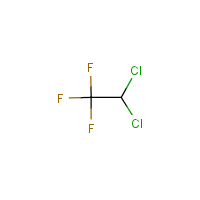1,1,1-Trifluoro-2,2-dichloroethane
Agent Name
1,1,1-Trifluoro-2,2-dichloroethane
CAS Number
306-83-2
Formula
C2-H-Cl2-F3
Major Category
Solvents

Synonyms
2,2-Dichloro-1,1,1-trifluoroethane; CFC-123; Chlorofluorocarbon 123; Dichloro(trifluoromethyl)methane; FC 123; Freon 123; HCFC 123; HFA 123; Hydrochlorofluorocarbon; R 123; Refrigerant HCFC-123; Refrigerant R 123; Solkane 123; Ethane, 2,2-dichloro-1,1,1-trifluoro-; Dichlorotrifluoroethane; [ChemIDplus] SUVA 123; [MSDSonline]
Category
Chlorofluorocarbons
Description
Colorless liquid; [ICSC]
Sources/Uses
Used as a refrigerant in air conditioners, a fire extinguisher, a foam blowing agent, and a metal cleaner; [HSDB] Developed as a chlorofluorocarbon replacement; [AIHA]
Comments
An eye irritant; Can cause liver injury, narcosis, and cardiac arrhythmias; [ICSC] Effects in high-dose animal studies include anesthesia; [MSDSonline] Several clusters of occupational hepatitis have been reported, e.g., after HCFC-123 leaked in an air-conditioning system in a crane cabin and after HCFC-123 was used as a degreaser; [AIHA]
Biomedical References
Exposure Assessment
Vapor Pressure
718 mm Hg
Lethal Concentration
LC50 (rat) = 32,000 ppm/4h
Explanatory Notes
VP from ChemIDplus;
ERPG-1
Insufficient data
ERPG-2
1,000 ppm
ERPG-3
10,000 ppm
WEEL
50 ppm
Adverse Effects
Neurotoxin
Acute solvent syndrome
Hepatotoxin
Occupational hepatotoxin (principal effect)
Diseases, Processes, and Activities Linked to This Agent
Diseases
Occupational diseases associated with exposure to this agent:
Processes
Industrial Processes with risk of exposure: